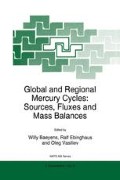Abstract
One of the most important current tasks in research on mercury behaviour in the environment is the increase of our knowledge concerning its cycles and balances in regional scales, including those for different types of regions. Such studies depends very much upon the completeness and quality information regarding local emissions and fluxes of mercury (Hg). However, the magnitudes of the anthropogenic emissions of Hg from different point and diffuse sources, and the fluxes due to natural emissions from the Earth surface are still very uncertain in major cases. Recently the main natural sources and anthropogenic emissions, as well as Hg budgets, were estimated for Siberia, the largest part of the Russia (about 10 million km 2). The huge size of this region makes the problem not only locally significant, but globally too.
Access this chapter
Tax calculation will be finalised at checkout
Purchases are for personal use only
Preview
Unable to display preview. Download preview PDF.
References
Obolensky, A.A., Ozerova, N.A., Vasiliev, V.I. (1995) Natural Mercury Sources in Siberia, Chemistry for Sustainable Development 3, No.1–2, 11–21.
Obolensky, A.A. (in press) Natural Mercury Sources in the Environment: Contribution of Siberia, Submitted for publication in the same book (NATO ARW on Mercury, Novosibirsk, 1995).
Yagolnitser, M.A. et al. (1995) An Estimate of Industrial Mercury Emissions in Siberia, Chemistry for Sustainable Development 3, No. 1–2, 23–34.
Yagolnitser, M.A. et al. (in press) Industrial Mercury Sources in Siberia, Submitted for publication in the same book (NATO ARW on Mercury, Novosibirsk, 1995).
Mercury in the Swedish environment (1991) Recent research on causes, consequences and corrective methods, Kluwer Academic Publisher, Dordrecht.
Linqvist, O., Jernelov, A., Johansson, K., and Rodhe, H. (1984) Mercury in the Swedish environment, Global and local sources, SNV PM 1816, Swedish Environmental Protection Agency, S-171 85 Solna, Sweden.
Pacyna, J.M. (1987) Atmospheric emission of arsenic, cadmi urn, lead and mercury from high temperature processes and in power generation industry, Lead, mercury, cadmium and arsenic in the environment (SCOPE 31), Chichester et al.: Wiley and Sons, 69–88.
Nriagu, J.O., Pacyna, J.M. (1988) Quantitative assessment of wordwide contamination of air, water and soil by trace metals, Nature 33, 1334–1339.
Fitzgerald, W. (1986) Cycling of mercury between the atmosphere and oceans, NATO ASI ser., C185, 363–408.
Yanin, E.P. (1992) Mercury in the environment of an industrial city, IMGRE, Moscow, (in Russian)
Mikhailov, N.I. (1976) Siberian nature. Geographical aspects, Mysl, Moscow, (in Russian)
Koropachinskii, I.Yu., Sedelnikov, V.P. (1994) Plant resources of Siberia: their current state and protection, Sibirskii Ecologicheskii Zh., No. 1, 17–28. (in Russian)
Sokolov, V.A., Atkin, A.S., Semechkin, I.V. (1994) Wood resources of Siberia, Sibirskii Ekologicheskii Zh., No. 1, 39–46. (in Russian)
Pomus, M.I.(editor) (1971) Soviet Union. Russian Federation. West Siberia, Mysl, Moscow, (in Russian)
Neishtadt, M.I. (1971) World natural phenomenon — bogging up of West Siberian plain, Izvestiya AN SSSR, Seriya Geographiya, No. 1, 21–34. (in Russian)
Kats, N.Ya., Neishtadt, M.I. (1963) Wetlands, West Siberia, Izdatelstvo AN SSSR, Mosccw, 230–249. (in Russian)
Obolensky, A.A. (1985) Genesis of deposits of the mercury ore formation, Nauka, Novosibirsk, (in Russian)
Coquery, M., Cossa, D., Martin, J.M. (1995) The distribution of dissolved and particulate mercury in three Siberian estuaries and adjacent Arctic coastal waters, Water, Air and Soil Pollution 80, 653–664.
Author information
Authors and Affiliations
Editor information
Editors and Affiliations
Rights and permissions
Copyright information
© 1996 Kluwer Academic Publishers
About this chapter
Cite this chapter
Sukhenko, S.A., Vasiliev, O.F. (1996). A Regional Mercury Budget for Siberia and the Role of the Region in Global Cycling of the Metal. In: Baeyens, W., Ebinghaus, R., Vasiliev, O. (eds) Global and Regional Mercury Cycles: Sources, Fluxes and Mass Balances. NATO ASI Series, vol 21. Springer, Dordrecht. https://doi.org/10.1007/978-94-009-1780-4_5
Download citation
DOI: https://doi.org/10.1007/978-94-009-1780-4_5
Publisher Name: Springer, Dordrecht
Print ISBN: 978-94-010-7295-3
Online ISBN: 978-94-009-1780-4
eBook Packages: Springer Book Archive

